
Gilbert de Clare, 6th Earl of Hertford, 7th Earl of Gloucester, 3rd Lord of Glamorgan, 9th Lord of Clare was a powerful English noble. He was also known as "Red" Gilbert de Clare or "The Red Earl", probably because of his hair colour or fiery temper in battle. He held the Lordship of Glamorgan which was one of the most powerful and wealthy of the Welsh Marcher Lordships as well as over 200 English manors.

Roger Mortimer, 1st Baron Mortimer, of Wigmore Castle in Herefordshire, was a marcher lord who was a loyal ally of King Henry III of England and at times an enemy, at times an ally, of Llywelyn ap Gruffudd, Prince of Wales.

Roger de Quincy, 2nd Earl of Winchester, hereditary Constable of Scotland, was a nobleman of Anglo-Norman and Scottish descent who was prominent in both England and Scotland, at his death having one of the largest baronial landholdings in the two kingdoms.
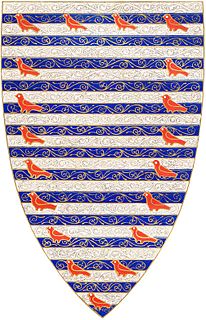
William de Valence, born Guillaume de Lusignan, was a French nobleman and knight who became important in English politics due to his relationship to King Henry III of England. He was heavily involved in the Second Barons' War, supporting the King and Prince Edward against the rebels led by Simon de Montfort. He took the name de Valence after his birthplace, Valence, near Lusignan.
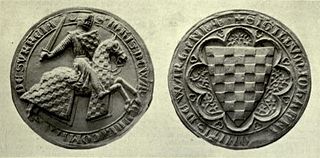
John de Warenne, 6th Earl of Surrey was a prominent English nobleman and military commander during the reigns of Henry III of England and Edward I of England. During the Second Barons' War he switched sides twice, ending up in support of the king, for whose capture he was present at Lewes in 1264. Warenne was later appointed a Guardian of Scotland and featured prominently in Edward I's wars in Scotland.

Eleanor of England was the youngest child of John, King of England and Isabella of Angoulême.
Sir Robert de Ros was an English nobleman.

Humphrey IV de Bohun, 2nd Earl of Hereford, 1st Earl of Essex was Hereditary Constable of England.
Peter de Montfort of Beaudesert Castle was an English magnate, soldier and diplomat. He is the first person recorded as having presided over Parliament as a parlour or prolocutor, an office now known as Speaker of the House of Commons. He was one of those elected by the barons to represent them during the constitutional crisis with Henry III in 1258. He was later a leading supporter of Simon de Montfort, 6th Earl of Leicester against the King. Both he and Simon de Montfort were slain at the Battle of Evesham on 4 August 1265.

Robert V de Brus, 5th Lord of Annandale, was a feudal lord, justice and constable of Scotland and England, a regent of Scotland, and a competitor for the Scottish throne in 1290/92 in the Great Cause. His grandson Robert the Bruce eventually became King of Scots.

Brougham Castle is a medieval building about 2 miles (3.2 km) south-east of Penrith, Cumbria, England. The castle was founded by Robert I de Vieuxpont in the early 13th century. The site, near the confluence of the rivers, Eamont and Lowther, had been chosen by the Romans for a Roman fort called Brocavum. The castle is scheduled as an Ancient Monument, along with the fort, as "Brougham Roman fort and Brougham Castle".
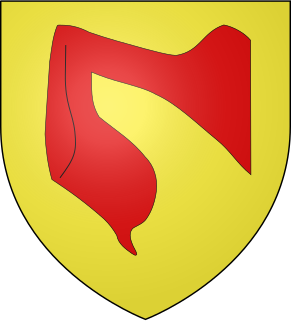
Henry de Hastings of Ashill, Norfolk, was a supporter of Simon de Montfort in his rebellion against King Henry III. He led the Londoners at the Battle of Lewes in 1264, where he was taken prisoner, and fought at the Battle of Evesham in 1265, where de Montfort was killed. He resisted King Henry III at Kenilworth and after the Dictum of Kenilworth he commanded the last remnants of the baronial party when they made their last stand in the Isle of Ely, but submitted to the king in July 1267. In 1264 he was created a supposed baron by de Montfort, which title had no legal validity following the suppression of the revolt.
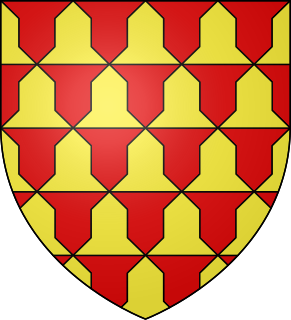
Robert de Ferrers, 6th Earl of Derby (1239–1279) was an English nobleman.

Vipont is the name of a prominent family in the history of Westmorland. According to Thomas the name originated in France before 1066 as Vieuxpont, Latinized to de Vetere Ponte, with alternative spellings Vezpont, Veepon, Vexpont, Vypont, Vispont, Vypunt, Vespont, Vipond, Vypond, Voypond, Veepond, Vippond, Vipon, Vipan, Vipen, etc. The Vipont family bore arms: Gules, six annulets or 3:2:1, later quartered by Baron Clifford.
Alice de Lusignan was the first wife of Marcher baron Gilbert de Clare, 7th Earl of Gloucester, and half-niece of King Henry III of England.
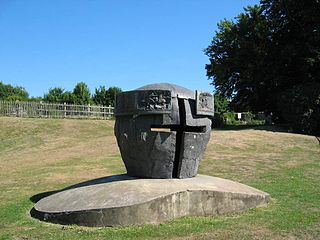
The Mise of Lewes was a settlement made on 14 May 1264 between King Henry III of England and his rebellious barons, led by Simon de Montfort. The settlement was made on the day of the Battle of Lewes, one of the two major battles of the Second Barons' War. The conflict between king and magnates was caused by dissatisfaction with the influence of foreigners at court and Henry's high level and new methods of taxation. In 1258 Henry was forced to accept the Provisions of Oxford, which essentially left the royal government in the hands of a council of magnates, but this document went through a long series of revocations and reinstatements. In 1263, as the country was on the brink of civil war, the two parties agreed to submit the matter to arbitration by the French king Louis IX. Louis was a firm believer in the royal prerogative, and decided clearly in favour of Henry. The outcome was unacceptable for the rebellious barons, and war between the two parties broke out almost immediately.

Robert de Vieuxpont was an Anglo-Norman landowner and administrator in the north of England.

There have been four different baronies held by the Marmion family, two feudal baronies, one purported barony created by Simon de Montfort and one barony by writ.

The feudal barony of Appleby was a feudal barony with its caput at Appleby Castle in Appleby, Westmorland, England.

Sir Bernard I de Bruce, Lord of Connington and Exton was an English knight from Huntingdonshire and Rutland. He was a younger son of Robert de Brus, 5th Lord of Annandale and Isabella de Clare.















